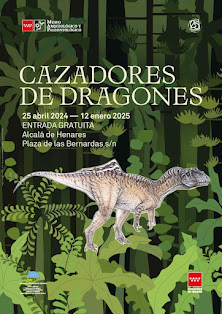Hace unos días se presentaron en el XVI Annual Meeting de la European Association of Vertebrate Paleontologist (EAVP), los restos apendiculares y axiales hallados en tres yacimientos enclavados en la orla mesozoica portuguesa y pertenecientes a tres nuevos individuos de ornitópodos anquilopollexios.
Los resultados preliminares presentados en este congreso corroboran que la composición de ornitópodos no estiracosternos del Jurásico Superior ibérico está compuesta al menos por dos formas, una de ellas exclusiva del este registro europeo como es Draconyx loureiroi y otra estrechamente relacionada con alguna de las especies conocidas del género Camptosaurus, pero que, hasta el momento, es difícil de definir debido a lo fragmentario y, por ende, no diagnóstico material fósil conocido.
Los resultados preliminares presentados en este congreso corroboran que la composición de ornitópodos no estiracosternos del Jurásico Superior ibérico está compuesta al menos por dos formas, una de ellas exclusiva del este registro europeo como es Draconyx loureiroi y otra estrechamente relacionada con alguna de las especies conocidas del género Camptosaurus, pero que, hasta el momento, es difícil de definir debido a lo fragmentario y, por ende, no diagnóstico material fósil conocido.
Aquí va el resumen:
The most common medium to large-sized ornithopod dinosaurs in the Late Jurassic are non-styracoste- rnan ankylopollexians. The ankylopollexian record from the Upper Jurassic of Portugal is not well-known and mainly based on fragmentary material from few fossil-sites located in the Lusitanian Basin. To date the presence of two species have been documented: Draconyx loureiroi and Camptosaurus aphanoecetes. In this context ankylopollexians discoveries in the Lusitanian Basin are noteworthy. Here additional material from three new localities is presented. Two localities have provided a set of well-pre- served caudal vertebrae, whereas a third locality have just provided an isolated femur. The former specimens (SHN 075 and SHN 074) come from the Sobral Formation at Atalaia (Lourinhã) and Praia da Amoreira-Porto Novo Formation at Atouguia da Baleia (Peniche) late Kimmeridgian-early Tithonian and late Kimmeridgian in age, respectively. The isolated femur [SHN(JJS) 073] comes from the locality of Peralta (Lourinhã. Sobral Formation, late Kimmeridgian-early Tithonian in age). Due to its fragmentary nature, the caudal vertebrae reported here cannot be assigned to none of the taxa described in the present-day Portuguese fossil record, and given the absence of diagnostic features are considered as Ankylopollexia indet. The femur from Peralta resembles those of Camptosaurus, but any autapomorphic feature can be con rmed, and lacks the autapomorphic character combination of the femur of Draconyx loureiroi. Therefore, the femur is here better to referred to Ankylopollexia indet. The new occurrences of non-styracosternan ankylopollexians indicates that medium to large-sized ornithopods were common dwellers during the Late Jurassic of southwestern Europe.
-----
Más información:
Más información:
- Referencia: Escaso, F., Malafaia, E., Mocho, P., Narváez, I., Sanz, J.L. and Ortega, F. New material of ankylopollexian ornithopods from the Upper Jurassic of Portugal. XVI Annual Meeting of European Association of Vertebrate Paleontologists, Abstract Book. 64.
- Imagen: Fernando Escaso en una instantánea durante una de las sesiones de explicación de los resultados llevados al congreso.





























No hay comentarios:
Publicar un comentario